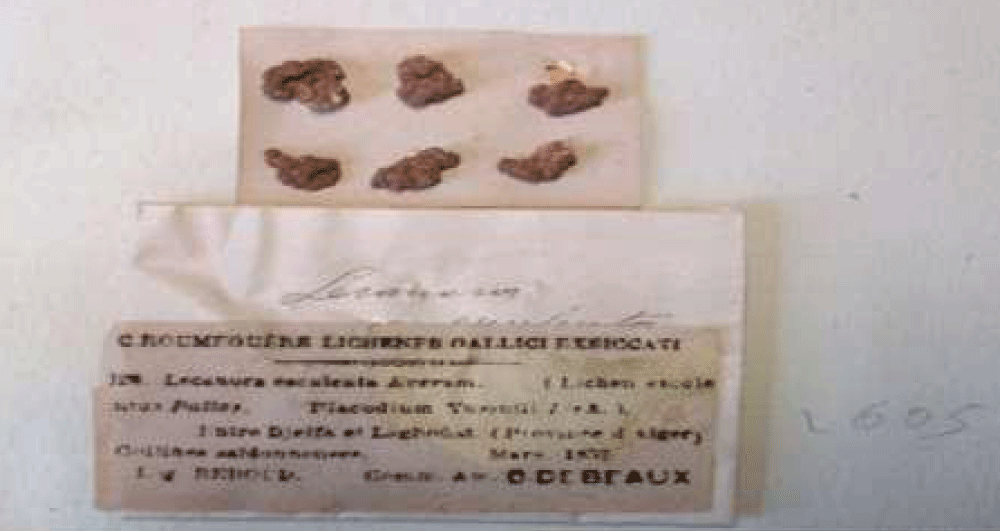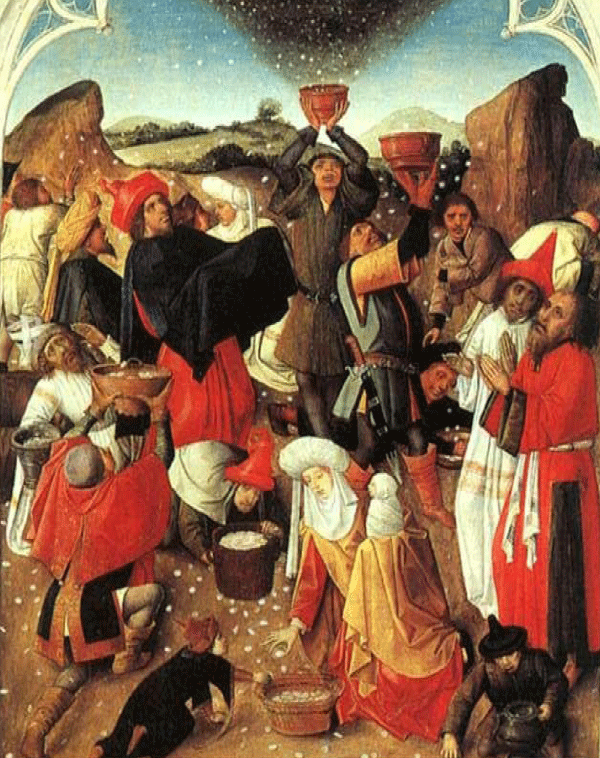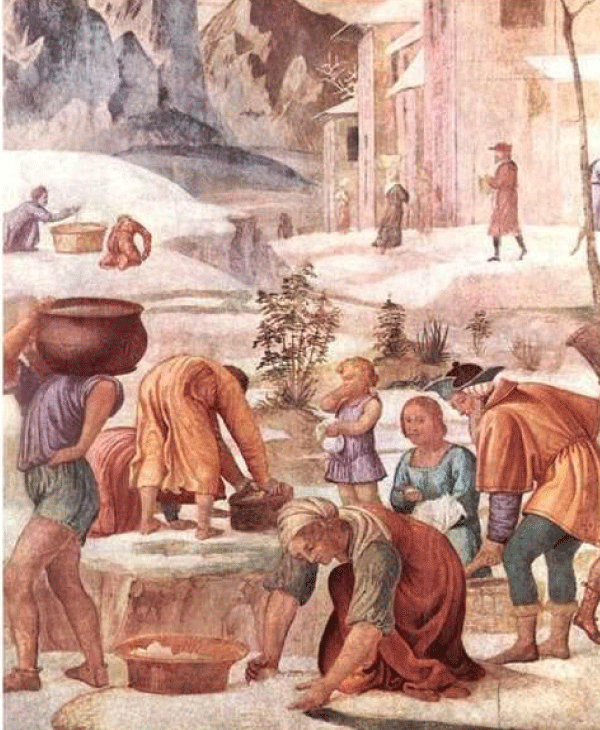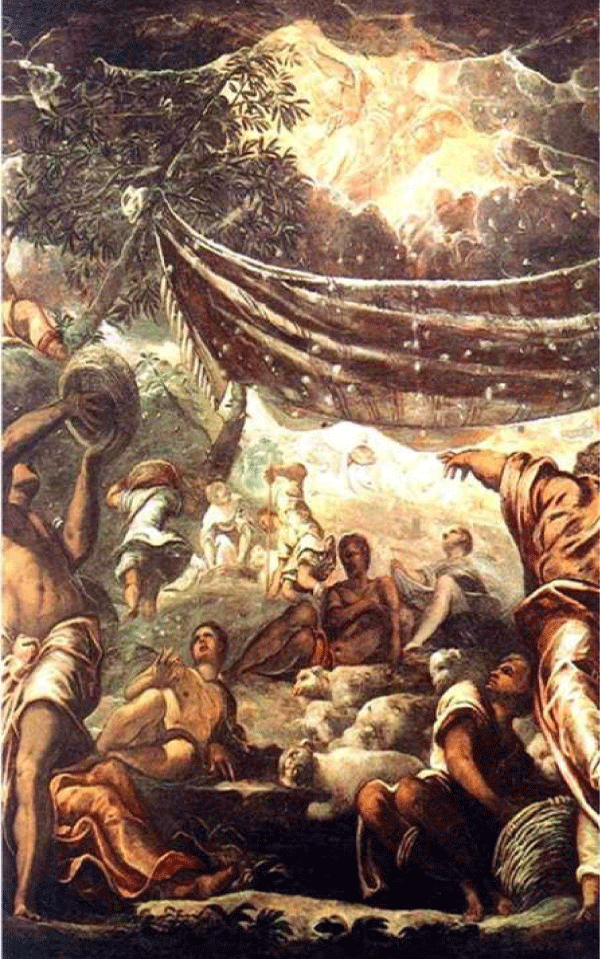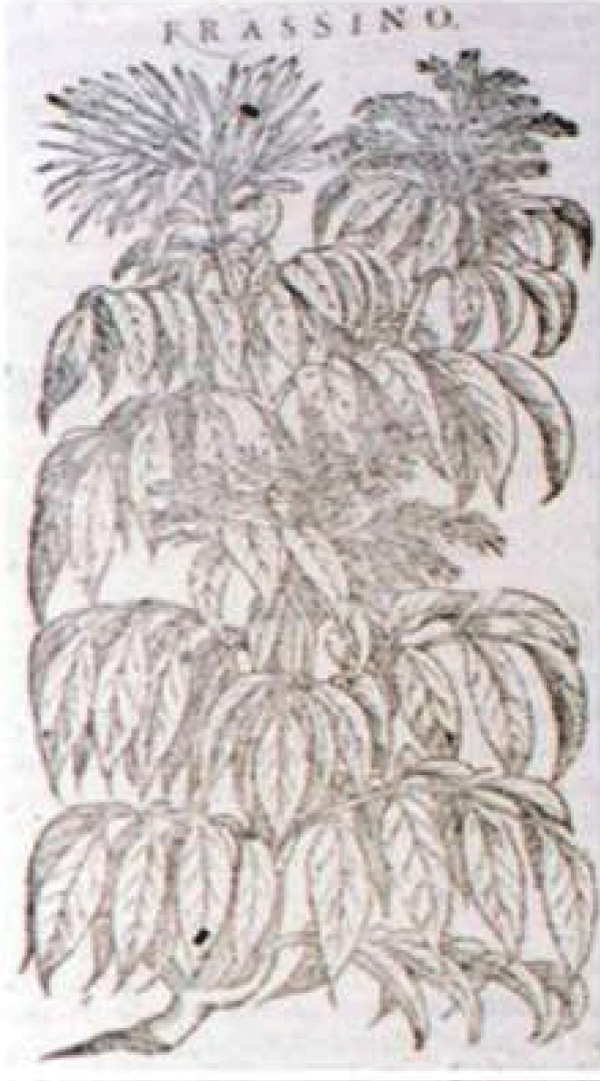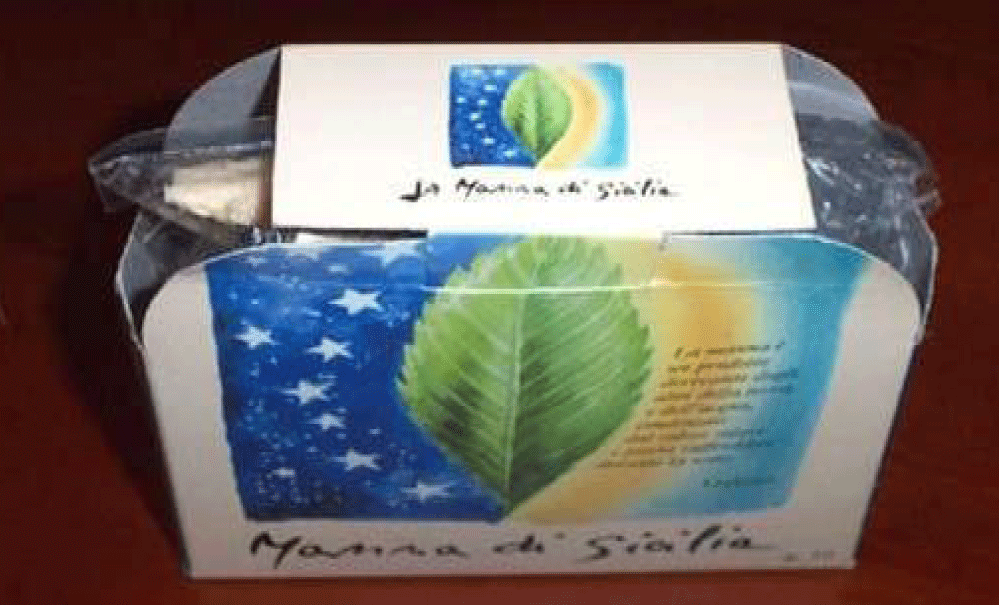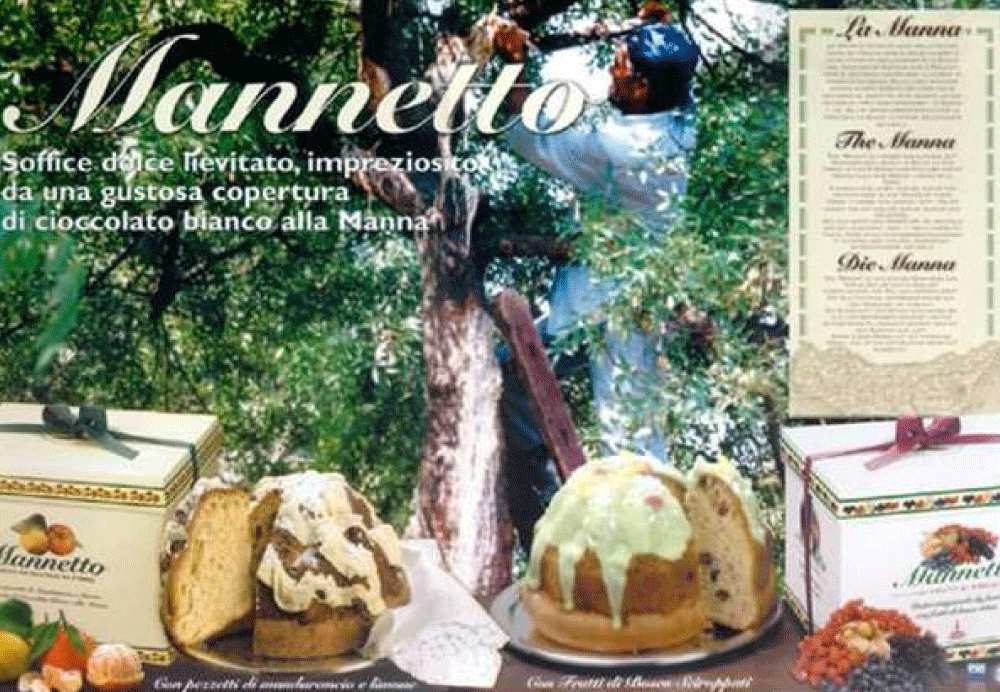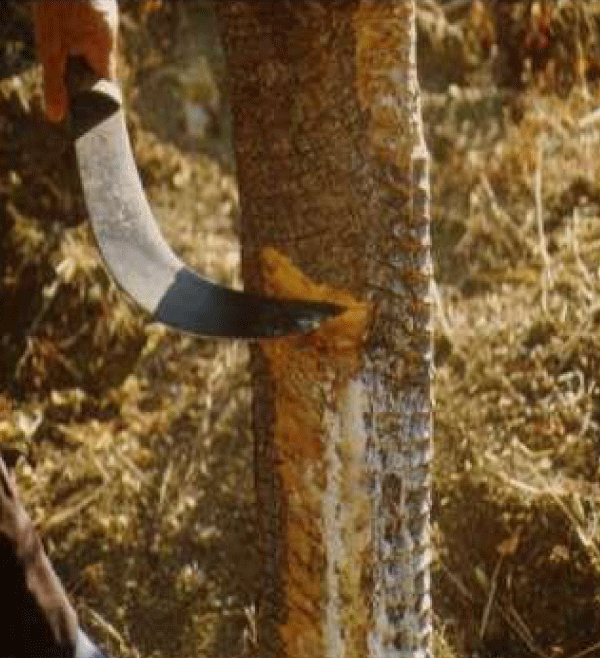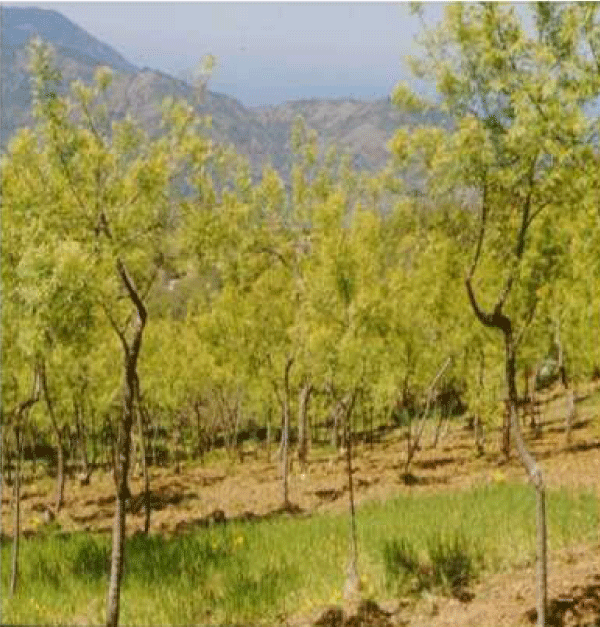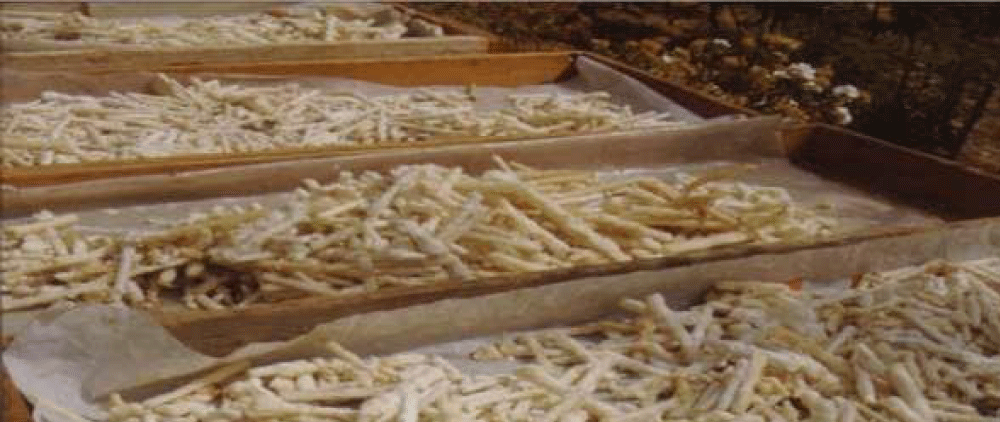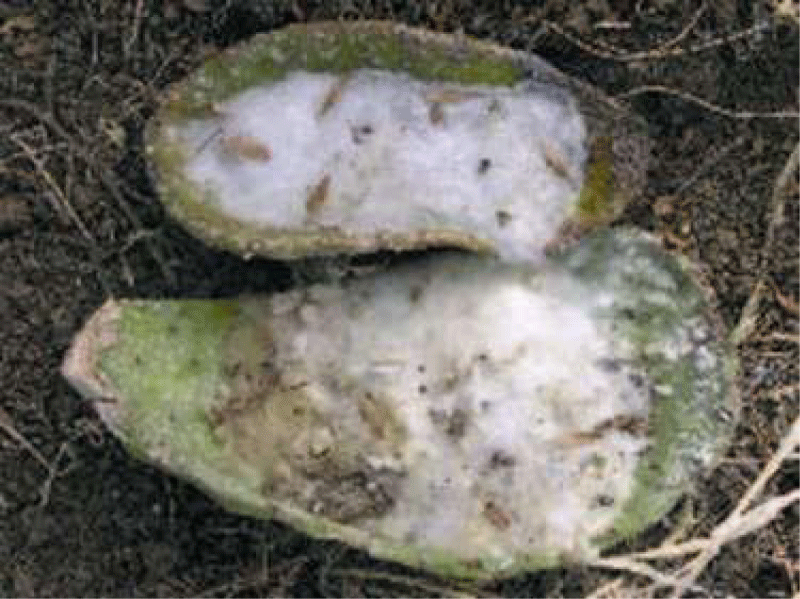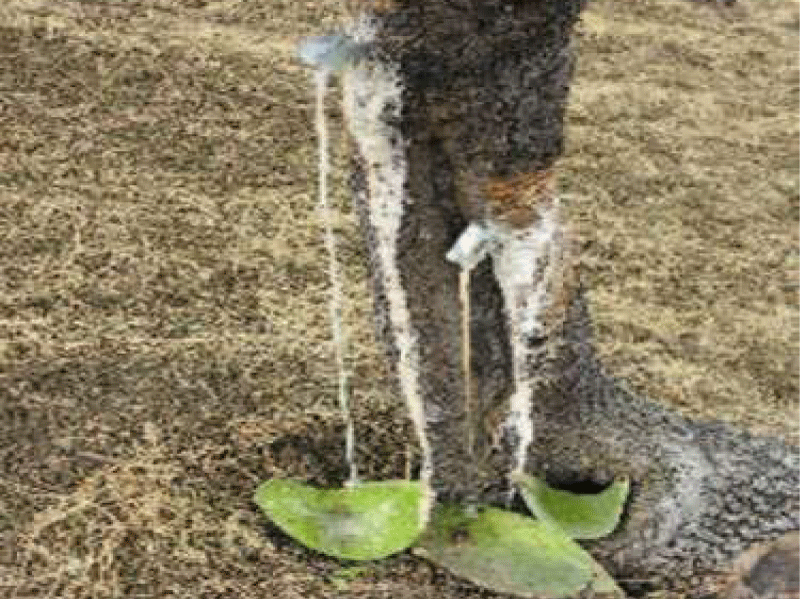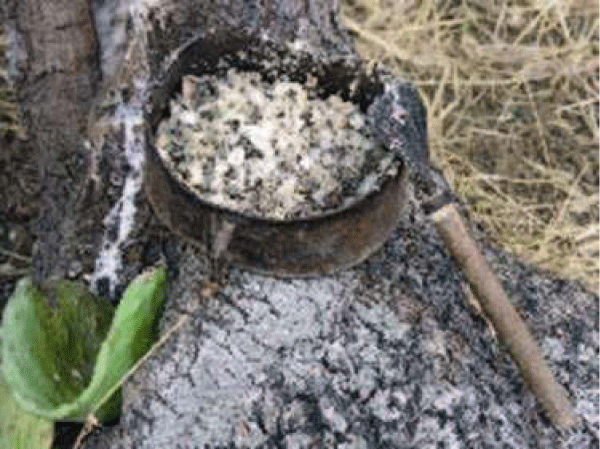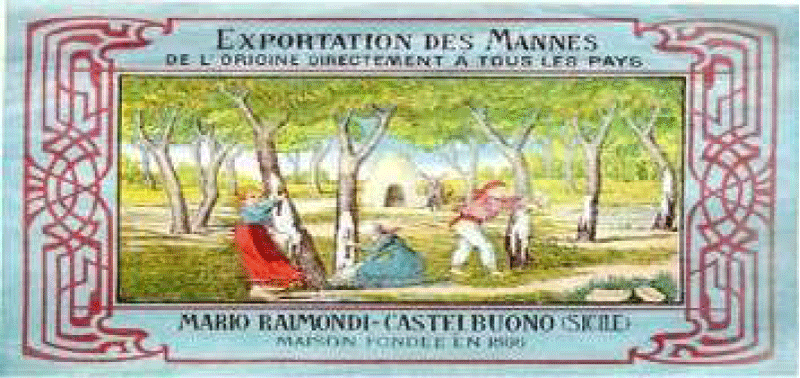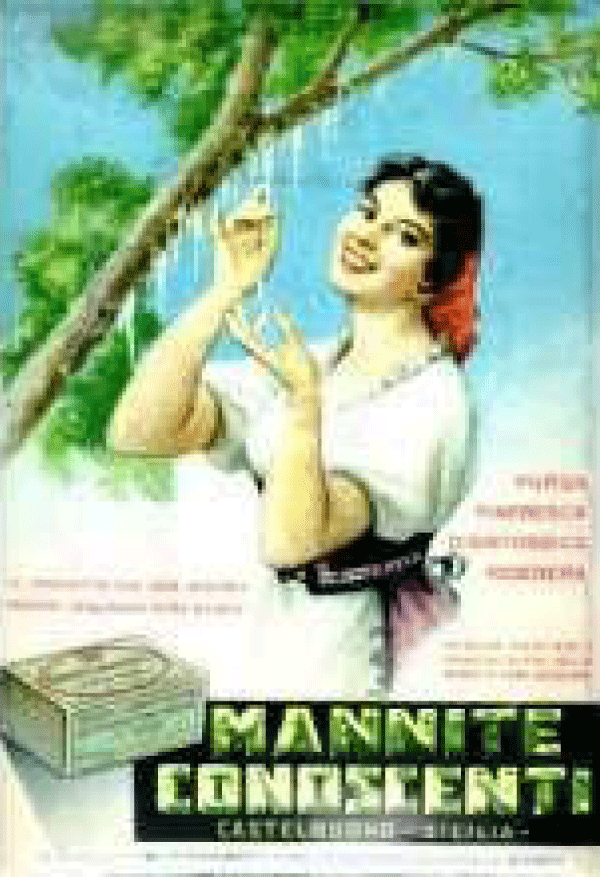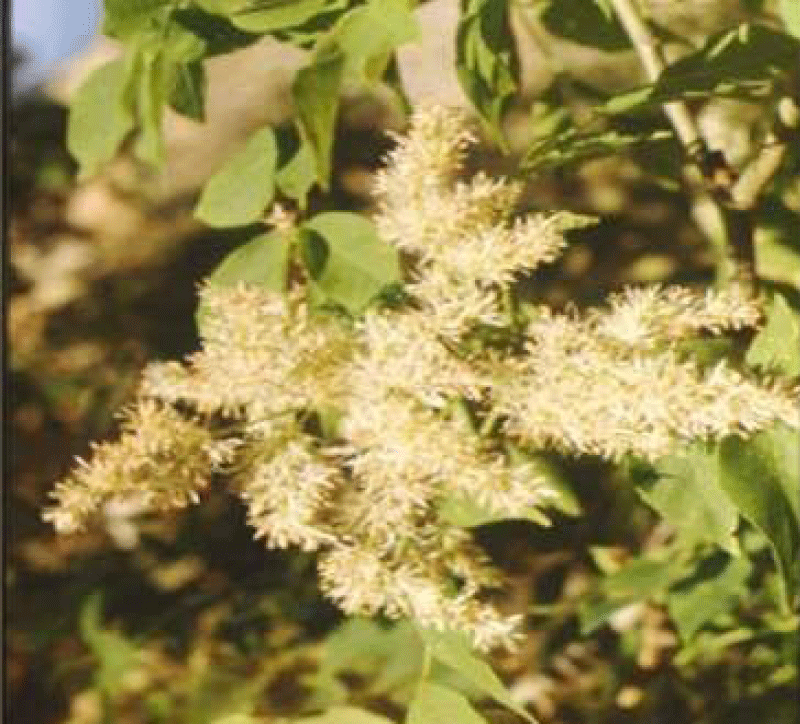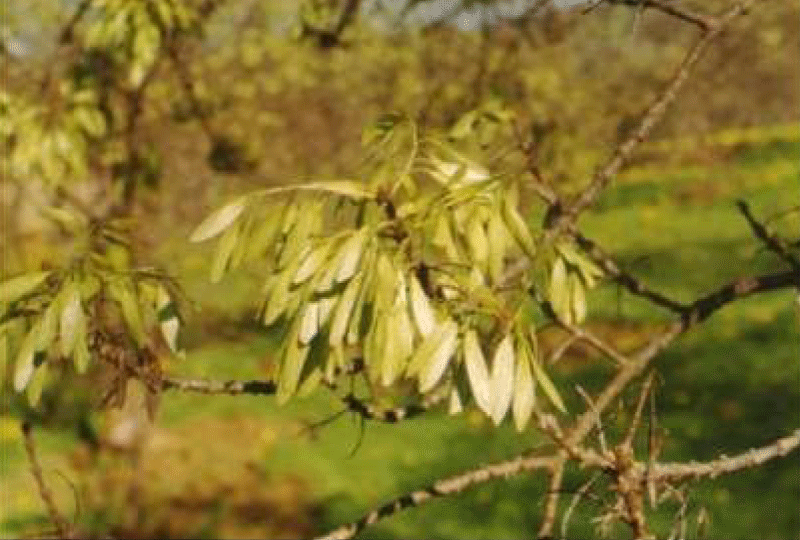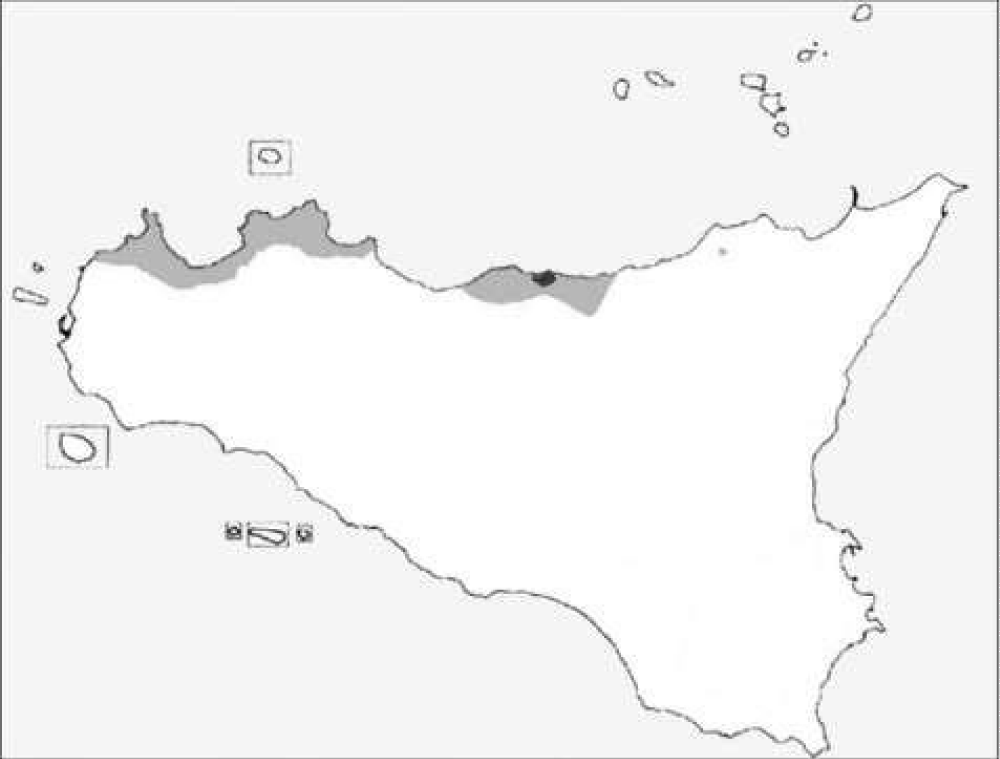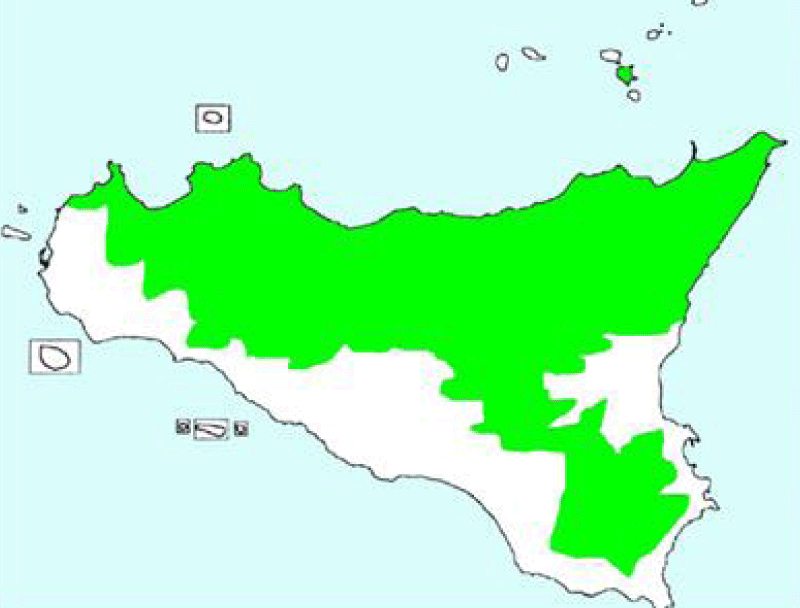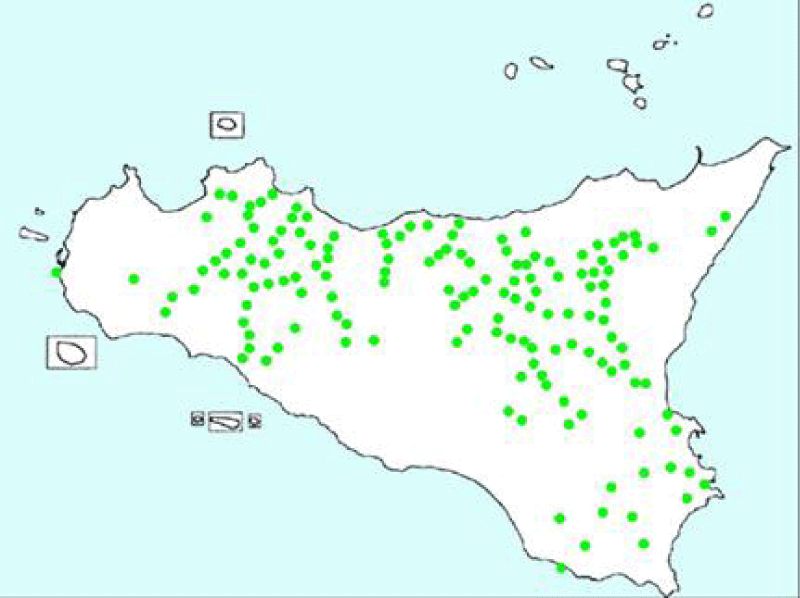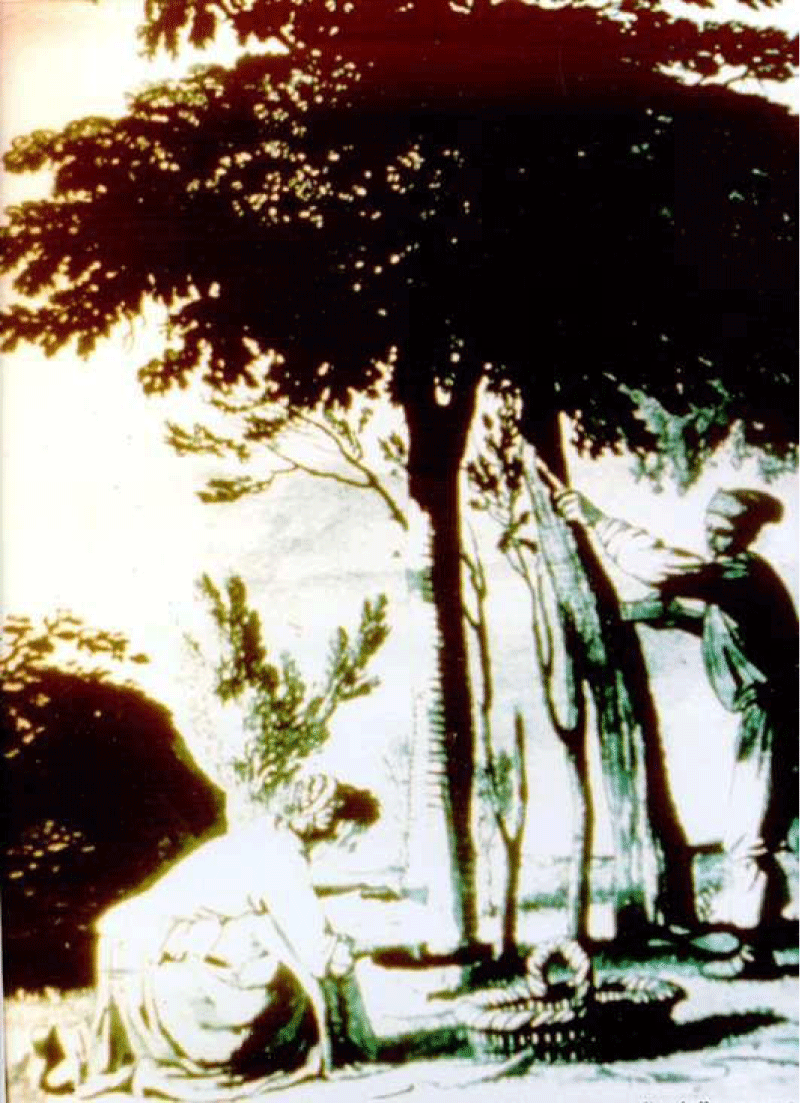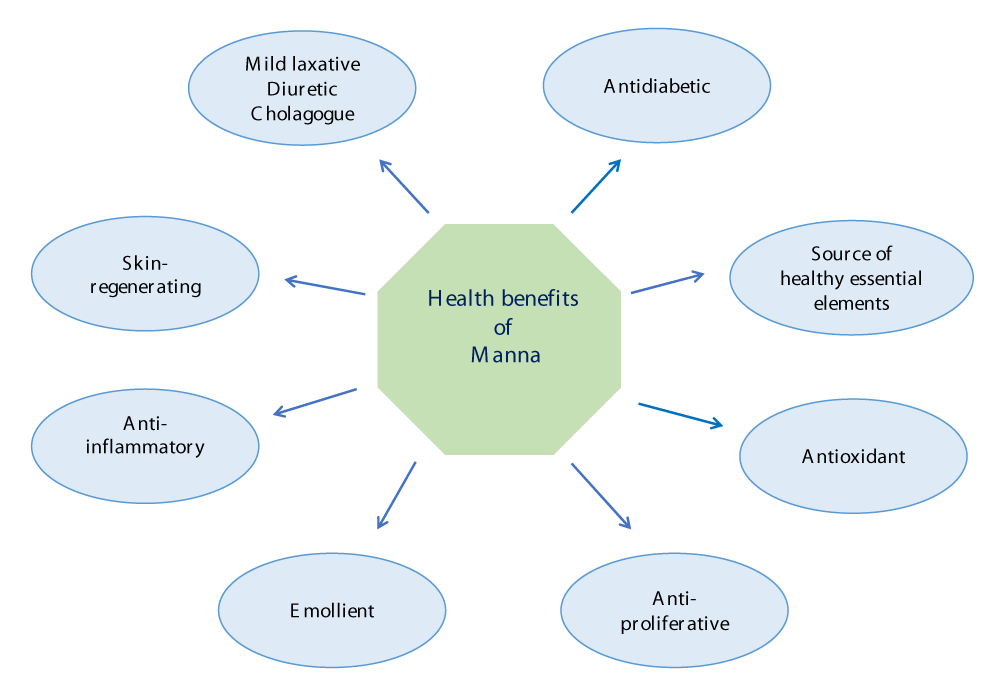More Information
Submitted: August 22, 2022 | Approved: August 30, 2022 | Published: August 31, 2022
How to cite this article: Spadaro V, Raimondo FM. The “manna” extracted from the ash trees still cultivated in Sicily from mythical food to pharmaceutical and nutraceutical resource. Arch Food Nutr Sci. 2022; 6: 038-048.
DOI: 10.29328/journal.afns.1001036
Copyright License: © 2022 Spadaro V, et al. This is an open access article distributed under the Creative Commons Attribution License, which permits unrestricted use, distribution, and reproduction in any medium, provided the original work is properly cited.
Keywords: Undernourished
The “manna” extracted from the ash trees still cultivated in Sicily from mythical food to pharmaceutical and nutraceutical resource
Vivienne Spadaro* and Francesco Maria Raimondo2
and Francesco Maria Raimondo2
1Department STEBICEF, Section of Botany, Anthropology and Zoology, University of Palermo, Via Archirafi 38, 90123 Palermo, Italy
2Planta, Center for Research, Documentation and Training, Via Serraglio Vecchio 28, 90123 Palermo, Italy
*Address for Correspondence: Vivienne Spadaro, Department STEBICEF, Section of Botany, Anthropology and Zoology, University of Palermo, Via Archirafi 38, 90123 Palermo, Italy, Email: [email protected]
“Manna” is the product obtained from the solidification of the elaborate sap that comes out of the incisions made during the summer season on the stem and on the main branches of some species of the genus Fraxinus (Oleaceae). The cultivation of manna ash trees dates back to ancient times in Sicily and elsewhere ash trees – known as sacred trees, a symbol of abundance and therefore auspicious – was increasingly widespread until the middle of the last century. Subsequently, however, the crop underwent a progressive decline, remaining relegated to restricted areas of Sicily, in particular in the Madonie district (Palermo, Italy). In this brief review, the essential characteristics of the manna and the ash trees from which it is extracted are summarized. The aspects of the current productivity of manna in the Sicilian territory and the implications of a potential recovery and increase of an ancient craft, ash tree cultivation, are also reported in a perspective of sustainable development and green economy for the Mediterranean area and beyond. Finally, the authors remember what has been done to ensure the conservation not only of the active cultivation of manna ash but also of all the relative agro-biodiversity. The conservation of the living germplasm of the ancient cultivars recovered in the Madonie area (Palermo, Sicily) represents one of the most qualifying results.
Different authors have tried to clarify the origin and meaning of the term “manna”. In the end, the most accredited opinions speak of a “gift of God”, referring to the biblical episode that will be recalled below. Objectively, the term “manna” is attributed to elaborate sugars of special plants, solidified following the release from the phloem tissues - once in contact with the dry air - due to insect bites, breakages caused by external agents, incisions made on some organs such as the trunk and main branches. In this regard, among the plants mentioned, there is Alhagi maurorum Medik. (Fabaceae), Anabasis articulata Choul. ex Pomel (Chenopodiaceae), Tamarix mannifera Kotschy ex Bunge (Tamaricaceae) as well as Fraxinus ornus L. and F. angustifolia Vahl (Oleaceae) [1-3].
As far as the subject of this synthetic review is concerned, the “manna” we are dealing with is the product of the solidification of the elaborated sap that comes out, in summer, from the incisions made on the stem of the aforementioned species of the genus Fraxinus L. (Oleaceae). In Sicily, the collection of manna from the ash tree dates back to the time of Arab domination (IX-XI century AD); from which the name of a locality in the territory of Cefalù (Palermo) was inherited. It is Gibilmanna – jebel-el-man (mountain of manna) – the name of the aforementioned Sicilian locality because in that place the ash trees produced “manna” [4].
The manna between myth and reality
According to modern readings of the Biblical episode concerning the escape of the Israelites from Egypt, the rain of manna that nourishes the people during the crossing of the Sinai desert, would correspond to the deposition of fragments of organic materials, suspended in the air [3,5,6]. One of them would correspond to the “manna lichen”, generally known as Lecanora esculenta Evers. [7,8] (Figure 1), an edible lichen, particularly widespread in today’s the Middle East. The wind can sometimes detach the hyphae that keep the thallus attached to the ground and carry the soft, rounded lichen over great distances. The Italian Encyclopedia Treccani [9], explains that the so-called ‘manna of the desert is composed of the thallus fragments of Lecanora esculenta. The thallus consists of white or yellowish glomeruli, which grow on the ground and form layers that can reach up to 5 cm thick. Winds can carry them in large quantities and let them fall far away (rain of manna). L. esculenta is also used today as a food by the Tatars, who call it “bread of the earth” and use it in the preparation of bread; it contains 10.75% of lichenin and 2.5% of inulin. Various species of this genus contain lecanoric acid (C16H14O7), an important secondary metabolite [10]; about that, the antitumor, antioxidant, antibacterial, and antifungal activities of this lichen compound were confirmed [11].
Figure 1: Specimen of the edible lichen Lecanora esculenta collected in the Algerian desert in March 1857 and preserved in the Herbarium Mediterraneum in Palermo (PAL).
The Biblical episode, in particular the fall from heaven and the collection of manna, will inspire the pictorial works of Italian artists as early as 1430-1550 (Figures 2-4). From here, it will be the botanical-medical treatise of Pietro Andrea Mattioli (1548) which refers to the manna of the ash tree (Figure 5), a plant species named by Carl Linnaeus [12], after two centuries, as Fraxinus ornus.
Figure 2: Anonymous called “The Magister of manna” (1470): The gathering of Manna. Oil on canvas (Museum of the Chartreuse, Douan (France).
Figure 3: Bernardino Luini (1509-1510): The Collection of Manna. Fresco (The Brera art gallery, Milan)./p>
Figure 4: Jacopo Tintoretto (1592-1594). Gathering the Manna, Oil on canvas (Venice, Scuola Grande, San Rocco School).
Figure 5: Iconographic plate of Fraxinus ornus (from Mattioli, 1548).
As early as 600 in Italy, F. ornus was cultivated for the extraction of manna in the south-central peninsula and in the islands of Sardinia and Sicily. And it is precisely in Sicily that this cultivation will continue to spread and be preserved up to the present day with alternating events that have also caused fear of its disappearance, averted thanks to local entrepreneurship that has meant that the manna of the ash trees found alternative uses to industry pharmaceutical company freed from the need to resort to drugs extracted from ash trees to obtain health products required by the market, the manna will enter on the one hand in sought after and expensive herbal products (Figure 6), on the other in the confectionery industry (Figure 7) and then again a nutraceutical, and recent in the gastronomic inventions of refined chefs [13].
Figure 6: One of the first commercial packages of “manna in cannolo” was made in the 1980s for the herbal market.
Figure 7: Advertising leaflet on artisan sweets produced with the “manna in rottame” once purified.
Figure 8: Trunk of manna tree in the moment of the morning incision moved up every day. We note the phloem liquid gushing from the deliberately inclined incision line to concentrate the same liquid along a narrow column that swells day by day if there is no summer rain. at the end of a week, it will help harvest.
Ash trees: source of plant drugs with multiple health properties
Ash trees are known as sacred, magical trees, a symbol of abundance and therefore auspicious and of eternal life. In the Scandinavian tradition, Fraxinus excelsior L., the common ash, a majestic tree, is considered the cosmic tree Yggdrasil, embodying the perfect balance between earth and sky [14]. Hippocrates and Theophrastus considered ash leaves a diuretic; Dioscorides and Pliny considered these capable of defeating the poison of the vipers, a virtue also reported many centuries later by Mattioli.
In the eighteenth century, the ash bark was also known as the “quinine of Europe” for its antifebrile and antimalarial actions, in fact, it was used as a substitute for quinine (that is, prepared from the bark of Cinchona L. species) to cure malaria [15]; in the following centuries, it was used above all as a general antirheumatic and antigout [16].
The name “ash” is linked to the traditional use of the ash from Fraxinus to wash linen and clothes. In addition, the ash tree bark was used for dyeing and leather tanning; the inner bark of Fraxinus excelsior is said to give a good blue color to cloth [17]. The reuse of ash tree for the extraction of a natural dye for textile dyeing was the subject of interesting research [18]; a quercetin-rich beige olive pigment extracted with distilled water from bark of F. excelsior, was used for dyeing wool fabrics with a good yield of the dyed material. Furthermore, the foliage of manna ash is excellent fodder for livestock, it is an effective source of protein for small ruminants during the dry Mediterranean summer [19]. Until the beginning of the twentieth century, dried ash leaves were part of winter cattle food ration. “Ash hay” is perfectly adapted for feeding nursing females for the high calcium concentration, twice higher than that of hay from natural meadows [15]. The decreasing use of these features may explain the abandonment of Fraxinus excelsior cultivation, and even F. ornus and F. angustifolia.
The genus Fraxinus is a source of various plant drugs (roots, bark of young branches, leaves, fruits, seeds, buds, and “manna”), containing a wide range of bioactive compounds, mainly secoiridoids, phenylethanoids, flavonoids, coumarins, and lignans, which perform numerous biological and pharmacological activities: hepatoprotective, diuretic, anti-inflammatory, antirheumatic, immunomodulatory, anticancer, neuroprotective, antihypertensive, antidiabetic, antimicrobial, antitoxoplasmosis, antioxidant, antiaging, wound healing potential [20-22].
In folk medicine, the leaf decoction of common ash was used as a diaphoretic and to treat arthritis; the leaf or the bark infusion was used as a laxative, against kidney and bladder stones and also as a pain reliever in cases of rheumatism and gout. The maceration of the ash leaves in the wine was drunk against the snakes and insect bites. The ash obtained by burning ash wood was mixed with olive oil and spread on the parts affected by scabies. Ash sprouts were eaten raw in salads or boiled as a vegetable [16].
In gemmotherapy, the fresh buds, seeds, and internal bark of the young branches of F. excelsior are used. In particular, the buds have anti-inflammatory, uricosuric, hypocholesterolemic, diuretic, and anti-cellulite activity; the seeds have aphrodisiac properties and are indicated in infertility and male impotence; the internal bark of the young two-year-old branches has febrifuges, anti-inflammatory, astringent and anti-diarrheal properties [14].
The seeds have been used traditionally as food or condiment and administered mainly for their hypoglycemic action in the treatment of metabolic disorders [23]; investigations on the patented seeds extract of F. excelsior (FraxiPureTM) confirmed this property, and also the safety and tolerability of this extract for consumption in healthy subjects [24].
Furthermore, Fraxinus angustifolia, the narrow-leaved ash, a plant with a centuries-old use for the production of manna, is a precious source of seeds rich in a fixed oil with potential use as an antioxidant and antiproliferative agent in the food, cosmetic and pharmaceutical industries [25]; in addition, have been recently documented the antimutagenic, antigenotoxic and antiproliferative activities of the extracts from the leaves and bark of this plant [26].
The virtues of the manna: from the popular practice to the pharmaceutical, cosmetic and food industry
For a long time, the manna was shrouded in mystery and has been the subject of several fantastic interpretations.
Since the times of the Greeks, this substance was considered a kind of natural honey that was deposited on the trees or, as Pliny refers, a celestial dew that fell on the trees when the stars came out called “sweat of heaven”, “air honey”, or “saliva of the stars” [16]. It was the Arabs who debunked myths and legends about manna, discovering in Sicily, that the practice of extracting manna, for a long time before remained obscure.
A fundamental contribution to the study and retrieval of information on local Sicilian traditions, also linked to the manna ash trees, was provided by the Minà Palumbo’s herbarium concerning the flora of the Madonie territory (Palermo, Sicily); this, thanks to the ethnobotanical annotations reported on the labels from the herbarium samples [27].
Manna is the product obtained from the solidification of the elaborate sap getting out from the incisions, done during the summer season, on the bark of some Fraxinus species, precisely Fraxinus ornus and F. angustifolia (Figure 8). Currently the production of manna is mainly based on some cultivars of F. angustifolia (Figure 9), which compared to those of F. ornus have the advantage of entering into production very early, although they produce qualitatively less valuable manna.
Figure 9: Cultivation of manna ash (Fraxinus angustifolia) in the Castelbuono (Palermo) countryside.
Three types of manna are distinguished and precisely, the cerulean liquid which solidifying forms a whitish stalactite is the “manna in cannolo” or “manna eletta”, the most valuable (Figure 10); the liquid that drains and is collected by prickly pear pads, i.e cladodes of Opuntia ficus-indica (L.) Miller is the “manna in sorte” or “manna di pala” (Figure 11) and finally, the part of sap that solidifies along the trunk (Figures 12,13) is the “manna in rottame” [28].
Figure 10: The precious “manna in cannoli” is placed to dry after harvesting on specific drying racks.
Figure 11: The manna derived from the dripping on prickly pear cladodes of the elaborate sap coming out of the incisions of the ash tree trunk, following its solidification, takes the local name “manna di pala”.
Figure 12: The base of the trunk of a manna tree is engraved; the solidified manna on the surface is evident both on the trunk and in the cladodes of prickly pear (Opuntia ficus-indica).
Figure 13: The manna scraped from the trunk in a special zinc container, called “scatula”, constitutes the “manna in sorte” or “manna in rottame”.
The chemical composition of the manna is rather complex and variable quality-quantitatively, this depends, in addition to the species and the cultivar, on the conservation of the finished product and again, on various other factors, such as the type of manna itself, the locality of origin, the chemical-physical characteristics of the soil, the seasonal climatic trend, the exposure of ash wood and the age of the ash tree.
The most abundant active ingredient is mannitol or D-mannitol (about 60%), a colorless, odorless, and sugary flavored hexavalent alcohol also known as “manna sugar”; there are also carbohydrates (glucose, fructose mannotriose, mannotriose), mineral elements (potassium, magnesium, calcium), organic acids (lactic, succinic, malic), water, mucilages, tannins and traces of minor components not yet well identified [28,29].
Mannitol is used as a reserve carbohydrate by some bacteria, fungi, brown seaweeds, and some higher plants [30]. Mannitol, like other polyols, may be involved in different physiological processes of plants, mainly as an osmotically active compatible solute. The manna ash trees are traditionally cultivated in Sicily, i.e. Fraxinus ornus and F. angustifolia showed a significant increase in mannitol content in response to drought summer conditions (Oddo, et al. 2002); in particular, mannitol reached a maximum value at the end of the dry season. The temperature did not have a direct influence on mannitol content. Milburn, et al. [31] suggested that drought promotes the rate and duration of exudation of the unusually concentrated sap.
Moreover, investigations conducted by Oddo, et al. [32] on the manna produced from the two Fraxinus species have shown that there is a great difference in the mannitol content of the manna produced: the manna of F. ornus contains about three times more mannitol than that by F. angustifolia. On the other hand, with regard to the mannitol content of the different commercial qualities of the manna of the same species, the differences found were not significant.
The manna for its mannitol content could play an interesting role in all those fields that have an impact on health. As regards to health potential of polyols as sugar replacers, Levesen [33] reports that they have many potential health benefits; they are non-cariogenic (sugar-free tooth-friendly), low-glycaemic (potentially helpful in diabetes and cardiovascular disease), low-energy, and low-insulinemic (potentially helpful in obesity), low-digestible (potentially helpful in the colon), osmotic (colon-hydrating, laxative and purifying) carbohydrates. The same properties apply to mannitol. Besides, several pieces of evidence indicate that approximately 25% of oral mannitol in solution is absorbed and thus, the rise in blood glucose and demand for insulin is much less than would be experienced after sucrose ingestion. Absorbed mannitol is excreted in urine because it is virtually non-metabolizable in the tissues and the remainder of unabsorbed mannitol is slowly fermented. No data on the effects of mannitol on the gut microbiota are available [34].
Schicchi, et al. [28] analyzed the composition of the manna “in cannolo” of some cultivars, mainly of F. angustifolia, in relation to the harvest time. The data obtained highlight not only the chemical composition of the manna produced by each cultivar but above all the quantitative variations of its main constituents. Tables 1-4, taken from the aforementioned study, can give a qualitative and quantitative indication of the constituents of the manna produced by some cultivars, as well as the quantitative variations that occur in the different manna in relation to the harvest times. Significant variations instead occur depending on the harvest times of production and after storage conditions.
| Table 1: Composition of the “manna in cannolo” from F. ornus cv. “Serracasale” was collected in the year 2005 in the locality Serracasale [from Schicchi, et al. (2011), reworked]. | |||
| Analytical results (g/100 dry wt.) | Collection times | ||
| 10-08-2005 | 14-08-2005 | 05-09-2005 | |
| Glucose | 2.36 | 2.33 | 3.03 |
| Fructose | 2.57 | 2.54 | 5.36 |
| Mannotriose | 15.56 | 16.11 | 14.80 |
| Mannotetrose | 18.94 | 19.15 | 18.52 |
| Mannitol | 47.36 | 47.18 | 51.35 |
| Tot. hydrates of carbon + Mannitol | 86.79 | 87.31 | 93.06 |
| Ashes | 4.83 | 4.86 | 1.80 |
| Sulfates | 0.45 | 0.51 | 0.12 |
| Chlorides | 0.08 | 0.07 | 0.31 |
| Potassium | 0.51 | 0.49 | 1.01 |
| Magnesium | 0.04 | 0.04 | 0.17 |
| Calcium | 0.08 | 0.07 | 0.20 |
| Humidity (g/100) | 5.85 | 5.25 | 2.88 |
| Table 2: Composition of the “manna in cannolo” from cv. “Verdello” was collected in the year 2004 in two localities, on the 1st, 3rd and 6th day after incision [from Schicchi et al. (2011), reworked]. | |||
| Locality/Collection times | Locality/Collection times | ||
| Analytical results (g/ 100 dry wt.) |
Experimental field IPAA | Locality Croce Foresta | |
| 1st d (16.08.04) | 6th d (22.08.04) | 3rd d (18.08.04) | |
| Glucose | 2.33 | 2.64 | 3.09 |
| Fructose | 2.46 | 3.78 | 3.86 |
| Mannotriose | 8.04 | 11.72 | 9.21 |
| Mannotetrose | 9.02 | 14.02 | 11.3 |
| Mannitol | 58.33 | 53.91 | 54.73 |
| Total hydrates of carbon + Mannitol | 80.18 | 86.07 | 82.19 |
| Ashes | 2.04 | 2.05 | 1.93 |
| Chlorides | 0.026 | 0.028 | 0.06 |
| Sulfates | 0.42 | 0.56 | 0.37 |
| Potassium | 0.53 | 0.58 | 0.64 |
| Magnesium | 0.069 | 0.072 | 0.03 |
| Calcium | 0.086 | 0.095 | 0.047 |
| Humidity (g/100) | 17.33 | 11.29 | 15.45 |
| Table 3: Composition of the “manna in cannolo” from cv. “Sarvaggiu” was collected in August 2005, in locality Carpaci, at time intervals of 2-4 days [from Schicchi et al. (2011), reworked]. | |||||||
| Analytical results (g/100 dry wt.) | Collection times | ||||||
| (11.8.05) | (14.8.05) | (17.8.05) | (19.8.05) | (22.8.05) | (25.8.05) | (29.8.05) | |
| Glucose | 3.15 | 3.19 | 3.15 | 3.14 | 3.11 | 3.04 | 2.98 |
| Fructose | 3.78 | 3.81 | 3.77 | 3.77 | 3.74 | 3.62 | 3.55 |
| Mannotriose | 15.07 | 15.14 | 14.88 | 15.27 | 15.33 | 15.43 | 15.56 |
| Mannotetrose | 19.44 | 19.67 | 19.55 | 19.76 | 19.81 | 20.12 | 20.27 |
| Mannitol | 48.22 | 48.17 | 49.11 | 48.57 | 48.34 | 48.20 | 48.25 |
| Tot. hydrates of carbon + Mannitol | 89.66 | 89.98 | 90.46 | 90.51 | 90.33 | 90.41 | 90.61 |
| Ashes | 3.54 | 3.57 | 3.61 | 3.63 | 3.67 | 3.47 | 3.52 |
| Chlorides | 0.09 | 0.10 | 0.11 | 0.11 | 0.12 | 0.09 | 0.10 |
| Sulfates | 0.35 | 0.38 | 0.40 | 0.39 | 0.41 | 0.36 | 0.37 |
| Potassium | 0.78 | 0.79 | 0.80 | 0.81 | 0.83 | 0.80 | 0.81 |
| Magnesium | 0.06 | 0.06 | 0.06 | 0.06 | 0.06 | 0.05 | 0.06 |
| Calcium | 0.12 | 0.13 | 0.13 | 0.13 | 0.13 | 0.11 | 0.12 |
| Humidity (g/100) | 6.36 | 5.97 | 5.42 | 5.36 | 5.24 | 5.67 | 5.40 |
| Table 4: Composition of the “manna in cannolo” from cv. “Nziriddu” was collected in the locality Cuba, on the same plant, in August 2005 [from Schicchi, et al. (2011), reworked]. | ||||||
| Analytical results (g/100 dry wt.) | Locality and collection times – C.da Cuba | |||||
| 3rd d. (6.8.05) | 3rd d. 13.8.05) | 3rd d. (16.8.05) | 3rd d. (19.8.05) | 3rd d. (25.8.05) | 3rd d. (28.8.05) | |
| Glucose | 3.71 | 3.48 | 3.45 | 3.4 | 3.31 | 3.28 |
| Fructose | 3.12 | 2.89 | 2.8 | 2.77 | 2.69 | 2.61 |
| Mannotriose | 12.03 | 13.52 | 13.62 | 13.73 | 13.47 | 13.46 |
| Mannotetrose | 12.93 | 15.63 | 15.71 | 15.74 | 16.5 | 16.42 |
| Mannitol | 53.44 | 50.96 | 50.88 | 51.13 | 49.31 | 48.33 |
| Tot. hydrates of carbon + Mannitol | 85.23 | 86.48 | 86.46 | 86.77 | 85.28 | 84.1 |
| Ashes | 3.72 | 4.5 | 4.55 | 4.57 | 4.73 | 4.8 |
| Chlorides | 0.1 | 0.1 | 0.11 | 0.09 | 0.13 | 0.12 |
| Sulfates | 0.54 | 0.42 | 0.49 | 0.42 | 0.45 | 0.39 |
| Potassium | 0.55 | 0.63 | 0.64 | 0.65 | 0.89 | 0.57 |
| Magnesium | 0.051 | 0.059 | 0.061 | 0.063 | 0.038 | 0.042 |
| Calcium | 0.077 | 0.081 | 0.084 | 0.086 | 0.072 | 0.085 |
| Humidity (g/ 100) | 10.41 | 8.5 | 8.39 | 8.15 | 7.72 | 7.52 |
Additionally, there are several other chemical compounds such as fatty acids (oleic, palmitic, linoleic, palmitoleic, stearic acids) and coumarins both in free and glycosidic forms (esculetin, fraxetina, lomatin). The phenolic fraction is represented by lignans (pinoresinol, syringaresinol) and phenols (tyrosol, dopaol, 4- hydroxyphenylacetic acid).
As for volatile substances, their presence is observed only in fresh manna samples, while they are reduced during the drying process; the analysis of these components, mainly evidences esters of palmitoleic acid and hexahydrofarnesol [28].
The polyphenolic profile of manna has been proposed as a marker of product authenticity and is considered in the evaluation nutritional and health properties attributed to manna [35].
In the pharmaceutical industry, the manna has long been known for its chemical characteristics, especially with regard to the preparation of mild osmotic laxatives recommended mainly for children’s and pregnant women’s constipation problems, because they have no irritating effects on the intestinal mucosa [33] (Figures 14,15). In addition to the well-known laxative, purifying, and emollient actions, the manna has many other health benefits; it has a cholagogue action; it has a fluidifying, emollient, and sedative action for cough with regard to the respiratory system; moreover, it can be considered a decongestant and calming, in the oropharyngeal, ocular and intimate mucous diseases and lastly it is able to attenuate the inflammatory phenomena and promote the healing of wounds [36].
Figure 14: One of the packages of the pharmaceutical product, known as mannite, was prepared in Castelbuono in the first decades of the 19th century, and distributed in France and Switzerland.
Figure 15: Brochure for the promotion of mannite still prepared in Castelbuono (Palermo) immediately after the Second World War.
Recently, it has been reported that the manna hydrophilic extract from Fraxinus angustifolia possesses reducing, antioxidant, and anti-inflammatory properties [37] for the quite high levels of phenols/polyphenols, with hydroxytyrosol, as one of the major components. Also these health benefits of manna, as others mentioned above, have mostly been ascribed to the properties of mannitol, an osmotically active cell-compatible polyol. Moreover, the Phyto complex extracted from manna of the same species exerts an anti-proliferative activity on human colon cancer cells [38].
The production of mannite from molasses is the main reason for the decrease in the use of manna in the pharmaceutical industry; however, the return to natural products has meant that the drug, especially the “manna in cannoli”, entered the herbal market and then, in the food sector, used as a natural sweetener, without interference on blood sugar, useful in cases of diabetes and slimming diets [20]; it is used for the preparation of local confectionery specialties as the “mannetto” (Figure 7), nougat, biscuits, candies) and also of liqueurs [13].
Manna is a natural supplement that can be used to replenish the loss of mineral salts, especially potassium, in people who for work or sports eliminate significant amounts. However, as regards consumption, it is recommended to use the “manna in cannoli” within one year of production. In fact, as we move away from the moment of production, the variations in mannitol and, above all, the increase in simple sugars, glucose and fructose, could make it less suitable for diabetics [28].
Manna can be considered a great source of essential elements, as documented for the manna of F. ornus and also, the leaves and bark of F. excelsior [39]; especially iron, rubidium, strontium, copper, and zinc are the trace elements also found in the manna of F. angustifolia [40]. Therefore, of its beneficial effects also of the levels of the essential trace elements, it could be useful generally as a supplement diet and also for subjects with diseases related to diabetes [41] in this regard, it is not only a suitable natural sweetener, as already mentioned but also a valid dietary supplement, for example in terms of zinc supplementation [42] a problem nutrient for diabetic persons. Of course, further studies are needed to define the correct dose of human body intake to avoid adverse effects.
The “manna eletta Delle Madonie”, the purest, has been a Slow Food Presidium since 2002 and is produced exclusively in the Madonie Regional Park; the characteristic high mannitol content and the low soluble sugar content determine a reduced energy value, and by the way, a sweetening power. Purity and quality are now periodically monitored and the use of metal wires hanging from branches to collect manna has reduced the levels of impurities [43].
Recently a new method has been patented to purify, and then requalify the waste material of manna that remains adherent to the bark of the tree [37].
In cosmetics, the manna – with its emollient characteristics – can be used as a valid ingredient in the preparation of creams and soaps; a concentrated extract of mannitol obtained from the manna of Fraxinus ornus showed promising properties for skin nutrition, such as improved epidermal barrier function, decreased inflammation and stimulation of the enzyme 5 alpha-reductase [44].
Certainly, the manna is a natural product with a wide spectrum of promising healthy properties, some of these already known in popular practice, others highlighted experimentally and many others still likely to be clarified or revealed; it is a product to be valued while preserving the typical and specific territorial.
Species and varieties of ash trees cultivated for the production of manna
There are two species of Fraxinus cultivated in Sicily, compared to the only species historically cultivated in other regions of Italy. In fact, in addition to Fraxinus ornus, Fraxinus angustifolia subsp. angustifolia is also cultivated. These are native species, with a wide geographical distribution, present in different natural habitats of the island. The two species of manna ash, like all others in the genus, are deciduous trees. F. ornus is a tree up to 20 m tall, with a cylindrical trunk and smooth bark; the leaves, imparipinnate, have leaflets varying in shape but all with an entire margin. Flowering is spring and is contemporary with the release of the leaves (Figure 16).
Figure 16: Particular of the flowering of Fraxinus ornus.
F. angustifolia, on the other hand, is a larger tree, with a more or less cylindrical trunk but with thick and wrinkled bark. The leaves are also imparipinnate, varying slightly in shape and much in the size of the leaflets which instead have a serrated margin. Furthermore, flowering and fruiting are winter and therefore take place in the absence of leaves on the plant (Figure 17).
Figure 17: Particular of the fruiting of Fraxinus angustifolia subsp. angustifolia.
Fraxinus ornus is a species of the Southern European-South Siberian geographical element. The species mainly lives on carbonate soils, but also on well-drained siliceous ones. In the natural environment, F. ornus is a significant part of various plant associations referred to as the Quercetalia ilicis Br.-Bl. ex Molinier 1934 order. It is found mainly in the evergreen woods of holm oak (Quercus ilex L.) and cork oak (Quercus suber L.). In Sicily (Figure 18) its presence in nature is widespread both in submontane, hilly, and coastal environments (100-1400 m a.s.l.), especially in the maritime slopes where the dry period, calculated according to the Bagnouls & Gaussen method, affects the spring-summer months, from mid-May to mid-September. In nature, the population of F. ornus is very variable and within it numerous varieties have been recognized that over time farmers have been able to select and propagate by grafting, giving rise to the varieties (cvs) described.
Figure 18: The extension of manna ash crops in Sicily before the Second World War (gray). In black, the relict area of the same cultivation, today limited to a few tens of hectares in the territories of Castelbuono and Pollina in the Province of Palermo.
Fraxinus angustifolia is also a species of the South European-South Siberian geographical element. Unlike F. ornus, it prefers siliceous soils, even clayey ones. In nature, the population resorts to the edges of waterways which are almost dry in summer, in the same climatic condition as F. ornus. Together with other species of other genera, it concurs to form some characteristics of forest (Mediterranean and submediterranean riparian gallery forests), both in the plains and in the hills. These are hygrophilous plant associations consisting mainly of various species of Salix L. and Populus L., as well as Ulmus canescens Melville and Alnus glutinosa (L.) Gaertn. referred to the Populetalia albae Br.-Bl. ex Tchou 1949 order. In Sicily (Figure 19), this ash is widely present in all the provinces, from the coast to the high hilly belt (50-900 m a.s.l.). In addition to the nominal subspecies (F. angustifolia Vahl subsp. angustifolia), F. angustifolia subsp. oxycarpa (Willd.) Franco & Rocha Afonso occur only in isolated locations (Raimondo, et al. 2019). The numerous cultivated varieties (cvs), all originated from the nominal subspecies.
Figure 19: Natural distribution area of Fraxinus ornus in Sicily.
Numerous cultivars of both species were cultivated in Sicily, all well described in an important monograph by the physician and naturalist Francesco Minà Palumbo [45], as well as documented in the herbarium created by the aforementioned scholar, now preserved in the Naturalistic Museum to him dedicated in the town of origin (Castelbuono, Palermo). The progressive abandonment of the cultivation of ash trees, over the years, has caused the loss of knowledge of the varietal heritage which remained intact until the beginning of the Second World War (1940). Since then, with the succession of generations of farmers no longer interested in the cultivation of manna ash, many varieties have been lost. As will be recalled later, a specific investigation aimed at the recovery of all the ancient varieties (cultivars) of ash was conducted and a representative part of the agro-biodiversity of manna ash was saved [46].
Cultivar of Fraxinus angustifolia subsp. angustifolia recovered [46].
‘Verdello’
‘Nziriddu’ or ‘Ziriddu’ ‘Baciciu’ or ‘Bacicci’
‘Russu’
‘Macigna’
‘Sarvaggiu’ ‘Tardiu’
‘Abbassa cappeddu’
‘Mastru Iachinu’ ‘Niuru’
‘Cavulu’ ‘Ciciri’ ‘Biancu
Cultivar of Fraxinus ornus recovered [46].
‘Serracasale’
‘Vitammare’
‘Titi’
The cultivar of F. angustifolia subsp. angustifolia has more abundant productions and produces earlier than F. ornus, but the manna is less valuable, less sweet, and does not show that white-candida color typical of F. ornus cultivar, it has a tendency to soften, yellow, or take on a color reddish as the months go by. As regards the cultivar of the two species, the most quantitatively productive cultivar corresponds to cv “Verdello”.
The current cultivation area in relation to the historical one
The manna trees cultivation in Sicily and elsewhere dates back to ancient times, and ash groves were increasingly spread up to half of the last century. Then, the cultivation had a progressive decline due to the abandonment of land and its gradual replacement by other crops. The area of cultivation of ash trees for the extraction of manna included a large stretch of the northern coast of Sicily, from Tusa (Messina) to Valderice (Trapani). This area has progressively reduced to a minimum size of a few tens of hectares (Figure 20).
Figure 20: Natural locations of Fraxinus angustifolia subsp. angustifolia in Sicily.
Protection and conservation of the manna trees cultivation in Sicily
As wild plants in Sicily, these ash trees participate in diversifying evergreen and deciduous oak woods as well as other forest communities at the watercourse borders, together with several species of the genera Salix, Populus, and Ulmus L., particularly in the hills.
Actually, most of the surface formerly occupied by ash trees is now uncultivated and therefore also exposed to recurrent fires. As a consequence, even the rich varietal heritage, documented by detailed monographs, went partially lost, although recently have not missed a revival of the local scientific community.
In the face of the many thousands of hectares occupied by these crops in the past, now residual plantations are confined to just a few hectares in the territories of Castelbuono and Pollina (Palermo), on the northern side of the Madonie mountains (Figure 20). In this area the plant landscape had been strongly characterized by the ash groves, that besides acted efficacious hydrogeological protection. At present, despite the progressive loss, the cultivation of manna ashes could still play an important role in the local economy. Therefore, in order to preserve all social, cultural, and even biological values as well as the landscape, it was proposed to establish a natural reserve of the manna ashes some decades ago; but that suggestion was later abandoned after the Madonie Natural Park was established. Nevertheless, the natural Park has not, over the years, affected concretely the further abandonment of ash groves and the protection and conservation of the related landscape: the same one that already in the 19th century attracted the attention of illustrious travelers on the Grand Tour, including the Frenchman Jean-Pierre Houël (Figure 21).
Figure 21: The cultural landscape of the Sicilian manna in an engraving by Jean-Pierre Hoüel ( in Voyage Pittoresque des Isles de Sicilie, de Malte, et de Lipari .1782-87; Paris.).
Recently, the Sicilian Regional government has adopted some measures aimed at supporting farmers in replanting ash groves: these are active conservation initiatives for the production of manna. Here we find it useful to propose even passive measures such as reforestation like those implemented elsewhere in the province of Palermo with good results for the environment and landscape. Other initiatives, that could not be postponed, concern vocational training as well as research and conservation of ash varieties germplasm to be grown in specific arboretums such as those already implanted in the fields of the agricultural schools [47-49].
Manna, no longer just a myth but reality, remains a unique natural product in the world and for this reason, it cannot fear competition; it risked disappearing with the prolonged abandonment of the cultivation of the plants that produce it. Fortunately, the manna today also attracts the attention of operators in the nutraceutical and food sector [13]. Therefore, the topic presented here supports the interest that the manna extracted from ash trees is being acquired in sectors other than pharmaceutical. Manna-based confectionery products (Figure 14) are enjoying increasing success among consumers, probably also recalled by the charm reminiscent of the myth of manna. Therefore, the manna of the ash trees – having found uses different from the traditional ones, even if they are niche – is still a natural resource capable of creating a new economy (Figure 22). From this perspective, it appears useful to experiment with the cultivation of manna ash trees outside its chosen area, in particular in those regions, even extra-Mediterranean, climatically compatible, where the costs of the required agricultural practices – mainly manual – can keep themselves economically sustainable in the medium and long term.
Figure 22: Health benefits of manna.
- Raimondo FM, Bonomo R, Lentini F. The manna ash in Sicily, a medicinal plant to be re-evaluated. Day Bot. Ital. 1980; 114 (3-4): 141-142.
- McKenna T. Food of the Gods: the search for the original tree of knowledge, a radical history of plants, drugs, and human evolution. Bantam Books. 1993.
- Wotton RS. What was manna?. Opticon 1826. 2010; 9.
- Raimondo FM, Ilardi V, Schicchi R. A presentation of the remains of the manna ash crop in the Mediterranean. The Echo of Gibilmanna. 1995; 157-164.
- Merkur D. The mystery of manna: the psychedelic sacrament of the bible. Park Street Press. 2000.
- Wong FK. Manna revisited: a study of the mythological and interpretative contexts of manna. Harvard Theological Review. 2002; 95(49): 459-461.
- Donkin RA. The" Manna Lichen": Lecanora esculenta. Anthropos. 1981; (H. 3./4): 562-576.
- Harrison SG. Manna and its sources. Kew Bulletin. 1950; 5(3): 407-417.
- Mameli Calvino E. Lecanora. In: Italian Encyclopedia. Treccani Institute of the Italian Encyclopedia, Rome. 1933.
- Winston I, Benson S, Minnick S. The significance of lichen compounds. Bulletin of the California Lichen Society. 2016; 23(2): 9-13.
- Goga M, Elečko J, Marcinčinová M, Ručová D, Bačkorová M, et al. Lichen metabolites: an overview of some secondary metabolites and their biological potential. Co-evolution of secondary metabolites. 2020; 175-209.
- Linnaeus C Fraxinus. Species Plantarum.1753; 2: 1057.
- Spadaro V, Raimondo FM. The manna of the Madonie (Sicily): from ash trees to pharmaceutical and food products. Mediterranean food. 2011; 1: 22-25.
- Piterà di Clima F, Nicoletti M. Gemmotherapy. Scientific foundations of modern Meristemotherapy. 2016; 405-410. Nuova Ipsa Editore s.r.l. Palermo.
- Carvalho AM, Castro J. Cultural aspects of the trees in selected European countries. Valbro-Cost E42: Valuable Broadleaved Trees in Europe. 2008.
- Peroni G. Driope, or the pact between man and nature. Treatise on phytotherapy. 2012; 392-395. Nuova Ipsa Publisher, Palermo.
- Adrosko RJ. Natural dyes and home dyeing. 2012; 281. Courier Corporation.
- Bechtold T, Mahmud-Ali A, Mussak RAM. Reuse of ash-tree (Fraxinus excelsior L.) bark as natural dyes for textile dyeing: process conditions and process stability. Color Technol. 2007; 123:271–279.
- Papachristou TG. Intake, digestibility and nutrient utilization of oriental hornbeam and manna ash browse by goats and sheep. Small Ruminant Research. 1997; 23(2-3): 91-98.
- Kinghora AD, Soejarto DD, Inglett GE. Sweetening agents of plant origin. Critical reviews in plant sciences. 1986; 4(2): 79-120.
- Kostova I, Iossifova T. Chemical components of Fraxinus species. Fitoterapia. 2007 Feb;78(2):85-106. doi: 10.1016/j.fitote.2006.08.002. Epub 2006 Nov 14. PMID: 17184933.
- Sarfraz I, Rasul A, Jabeen F, Younis T, Zahoor MK, Arshad M, Ali M. Fraxinus: A Plant with Versatile Pharmacological and Biological Activities. Evid Based Complement Alternat Med. 2017;2017:4269868. doi: 10.1155/2017/4269868. Epub 2017 Nov 27. PMID: 29279716; PMCID: PMC5723943.
- Visen P, Saraswat B, Visen A, Roller M, Bily A, Mermet C, He K, Bai N, Lemaire B, Lafay S, Ibarra A. Acute effects of Fraxinus excelsior L. seed extract on postprandial glycemia and insulin secretion on healthy volunteers. J Ethnopharmacol. 2009 Nov 12;126(2):226-32. doi: 10.1016/j.jep.2009.08.039. Epub 2009 Aug 31. PMID: 19723572.
- Flanagan J, Meyer M, Pasamar MA, Ibarra A, Roller M, Alvarez i Genoher N, Leiva S, Gomez-García F, Alcaraz M, Martínez-Carrasco A, Vicente V. Safety evaluation and nutritional composition of a Fraxinus excelsior seed extract, FraxiPure™. Food Chem Toxicol. 2013 Mar;53:10-7. doi: 10.1016/j.fct.2012.11.030. Epub 2012 Nov 28. PMID: 23201448.
- Giardinieri A, Schicchi R, Geraci A, Rosselli S, Maggi F, Fiorini D, Ricciutelli M, Loizzo MR, Bruno M, Pacetti D. Fixed oil from seeds of narrow-leaved ash (F. angustifolia subsp. angustifolia): Chemical profile, antioxidant and antiproliferative activities. Food Res Int. 2019 May;119:369-377. doi: 10.1016/j.foodres.2019.02.013. Epub 2019 Feb 6. PMID: 30884667.
- Bouguellid G, Russo C, Lavorgna M, Piscitelli C, Ayouni K, Wilson E, Kim HK, Verpoorte R, Choi YH, Kilani-Atmani D, Atmani D, Isidori M. Antimutagenic, antigenotoxic and antiproliferative activities of Fraxinus angustifolia Vahl. leaves and stem bark extracts and their phytochemical composition. PLoS One. 2020 Apr 16;15(4):e0230690. doi: 10.1371/journal.pone.0230690. PMID: 32298276; PMCID: PMC7161964.
- Mazzola P, Schicchi R, Venturella G. La cultura dei frassini attraverso l’erbario di F. Minà Palumbo. Museol. Sci.1990; 7 (3-4): 295-273.
- Schicchi R, Camarda L, Spadaro V, Pitonzo R. Chemical characterization of manna extracted in Madonie (Sicily) from cultivars of Fraxinus angustifolia and Fraxinus ornus (Oleaceae). Quad. Bot. Amb. Appl. 2006; 17 (2): 151-174.
- Lazzarini E, Lonardoni AR. The health manna from nature. Mediterranean Editions, Rome. 1984.
- Grembecka M. Sugar alcohols-their role in the modern world of sweeteners: a review. European Food Research and Technology. 2015; 241(1): 1-14.
- Milburn JA, Tyree MT, Lo Gullo MA, Salleo S. The physiology of sap transport in the genus Fraxinus. Proceedings of the European Society of Plant Physiology. 1980; 510-511.
- Oddo E, Saiano F, Bellini E, Alonzo G. Analysis of the mannitol content of manna from two species of ash grown in Sicily. Quad. Bot. Environmental Appl. 1997; 8 (1997): 61-63.
- Livesey G. Health potential of polyols as sugar replacers, with emphasis on low glycaemic properties. Nutr Res Rev. 2003 Dec;16(2):163-91. doi: 10.1079/NRR200371. PMID: 19087388.
- Ruiz-Ojeda FJ, Plaza-Díaz J, Sáez-Lara MJ, Gil A. Effects of Sweeteners on the Gut Microbiota: A Review of Experimental Studies and Clinical Trials. Adv Nutr. 2019 Jan 1;10(suppl_1):S31-S48. doi: 10.1093/advances/nmy037. Erratum in: Adv Nutr. 2020 Mar 1;11(2):468. PMID: 30721958; PMCID: PMC6363527.
- Caligiani A, Tonelli L, Palla G, Marseglia A, Rossi D, Bruni R. Looking beyond sugars: phytochemical profiling and standardization of manna exudates from Sicilian Fraxinus excelsior L. Fitoterapia. 2013 Oct;90:65-72. doi: 10.1016/j.fitote.2013.07.002. Epub 2013 Jul 10. PMID: 23850543.
- Cornara L, Sanclemente G, Robustelli della Cuna FS, Preda S, Raimondo FM. Manna, the gift of the Madonie. Herbal Medicine Tomorrow. 2017; 402: 74-85.
- Attanzio A, D'Anneo A, Pappalardo F, Bonina FP, Livrea MA, Allegra M, Tesoriere L. Phenolic Composition of Hydrophilic Extract of Manna from Sicilian Fraxinus angustifolia Vahl and its Reducing, Antioxidant and Anti-Inflammatory Activity in Vitro. Antioxidants (Basel). 2019 Oct 18;8(10):494. doi: 10.3390/antiox8100494. PMID: 31635261; PMCID: PMC6826888.
- Restivo I, Tesoriere L, Frazzitta A, Livrea MA, Attanzio A, Allegra M. Anti-Proliferative Activity of A Hydrophilic Extract of Manna from Fraxinus angustifolia Vahl through Mitochondrial Pathway-Mediated Apoptosis and Cell Cycle Arrest in Human Colon Cancer Cells. Molecules. 2020 Oct 30;25(21):5055. doi: 10.3390/molecules25215055. PMID: 33143282; PMCID: PMC7663425.
- Stoyanova M. Contents of mineral elements in leaves and bark of mountain ash (Fraxinus excelsior L.) and manna ash (Fraxinus ornus L.). Naukaza Gorata. 2009; 46(2): 65-72.
- Alaimo MG, Geraci A, Schicchi R, Varrica D. Preliminary study on trace metal content in manna extracted from Fraxinus angustifolia cultivars in Madonie (Sicily, Italy). Sdrp Journal of Earth Sciences & Environmental Studies. 2019; 4: 661-667.
- Moses AG, Maobe Gitu EGL., Rotich H. Profile of heavy metals in selected medicinal plants used for the treatment of diabetes, malaria and pneumonia in Kisii region, southwest Kenya. Global J. Pharmacol. 2012; 6(3): 245-251.
- Jurowski K, Szewczyk B, Nowak G, Piekoszewski W. Biological consequences of zinc deficiency in the pathomechanisms of selected diseases. J Biol Inorg Chem. 2014 Oct;19(7):1069-79. doi: 10.1007/s00775-014-1139-0. Epub 2014 Apr 19. Erratum in: J Biol Inorg Chem. 2015 Oct;20(7):1219. PMID: 24748223; PMCID: PMC4175048.
- Pezzana A, Bersani L, Baldereschi F, Ponzio R, Frighi Z, et al. An “LCA” Approach to Slow Food Presidia Products: From Agro-Environmental and SocioCultural Aspects to Economic Sustainability and Nutritional Evaluations. 2014; 9th International Conference LCA of Food. San Francisco, USA.
- Lubrano C, Touzeau B, Laperdrix C, Robin J. Development of a cosmetic plant active ingredient: sustainable and scientific considerations. The example of an ash manna tree extract (Fraxinus ornus L.). Planta Med. 2013; 79: 1110.
- Minà Palumbo F. Monografia sulla coltivazione del frassino. Agric. Ital. 1875-1876; 2(19): 307-312; (20): 363-366; (21): 407-411; (22-23): 487-491; (24): 554-559; (25): 606-612.
- Mazzola P, Schicchi R, Spadaro V. Ricerche finalizzate al recupero e conservazione del germoplasma dei frassini da manna sulle Madonie (Sicilia settentrionale). Atti 101° Congresso Soc. Bot. Ital., Caserta 2006: p. 137.
- Mazzola P, Raimondo FM, Spadaro V. Protection and conservation of the manna ash landscape in Sicily. In: Chiatante D, Domina G, Montagnoli A & Raimondo FM (eds). Sustainable restoration of Mediterranean forests (Palermo) – Fl. Medit. 2017; 27: 68-69.
- Attanzio A, Tesoriere L, Allegra M, Livrea MA. Phytochemicals and Nutraceuticals: the biochemical core of the Mediterranean plants. Bocconea. 2019; 28: 241-247.
- Raimondo FM, Salmeri C, Spadaro V. Problematicità tassonomiche e corologiche nel genere Fraxinus (Oleaceae) in Italia. Notiziario Soc Bot Ital. 2017; 1: 29-30.
